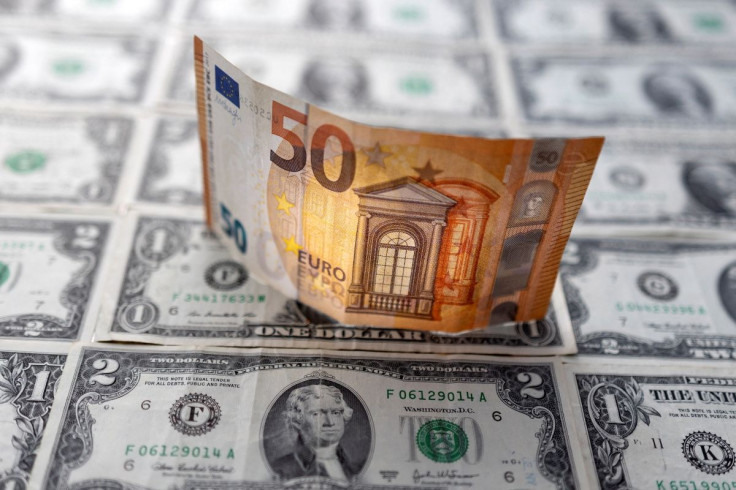Euro Clings To Parity As Markets Await U.S. Inflation Data

The euro hovered a whisker above parity to the dollar on Wednesday, with traders wary of the single currency being forced to levels unseen for decades if U.S. inflation data, due to be released later in the global day, shows a sky-high reading.
The greenback was firm in Asia trade, and neither the New Zealand dollar or South Korea's won drew much support from the expected 50-basis point increases in interest rates by their central banks.
The euro languished at $1.0036. It is down nearly 12% this year and fell to a 20-year low on Tuesday as the war in Ukraine has triggered an energy crisis that has hurt the continent's growth outlook. It dropped as low as $1.00005 on the most widely used Electronic Broking Services' dealing platform and touched $1 on Reuters dealing overnight.
Analysts say it could fall further if fast-rising U.S. consumer prices keep investors betting on U.S. rate rises.
Economists forecast headline U.S. inflation accelerated to 8.8% year-on-year in June, a 40-year high, which is likely to reinforce expectations of interest rate hikes and help the dollar.
"I think the U.S. dollar will keep increasing if the U.S. CPI is stronger than expected," said Commonwealth Bank of Australia strategist Joe Capurso in Sydney. "There's definitely a very good chance that the euro falls below parity tonight."
The euro fell below parity with the Swiss franc last month and is flirting with a drop beneath its 200-day moving average against the pound.
Weakness in the euro and yen has lifted the U.S. dollar index, which scaled a two-decade peak of 108.560 this week and was hovering at 108.18 in Asia trade on Wednesday.
The Japanese yen has taken a beating this year as the Bank of Japan sticks with its ultra-easy monetary policy in contrast with tightening nearly everywhere else.
It was under pressure at 137.05 per dollar on Wednesday after hitting its lowest since 1998 on Monday at 137.75.
The Australian dollar was steady at $0.6767, just above a two-year trough of $0.6712 made on Tuesday. [AUD/]
Sterling has also slipped on the stronger dollar and analysts see it adrift in the wake of the resignation of British Prime Minister Boris Johnson last week. [GBP/]
It last bought $1.19, with gross domestic product data due at 0600 GMT the next hurdle. Traders expect May brought zero growth.
Eight Conservatives are vying to succeed Johnson.
"The combination of slow growth, debt and high inflation is likely to prove very tricky for the new Tory leadership," said Rabobank senior strategist Jane Foley. "Sterling may suffer a lack of fresh direction until the new PM is in place."
In New Zealand and South Korea, the rate hikes came in largely as expected. The South Korean won was marginally firmer, while the New Zealand dollar dipped a fraction to $0.6131 - barely above Monday's two-year low of $0.6098.
"There was no real change in tone," said Jason Wong, strategist at BNZ in Wellington, of the Reserve Bank of New Zealand decision, adding that left U.S. CPI likely to drive the kiwi's next move. "We're at the whim of the U.S. dollar."
========================================================
Currency bid prices at 0519 GMT
Description RIC Last U.S. Close Pct Change YTD Pct High Bid Low Bid
Previous Change
Session
Euro/Dollar
$1.0035 $1.0036 +0.00% -11.72% +1.0047 +1.0023
Dollar/Yen
136.9800 136.8200 +0.12% +19.10% +137.2450 +136.9500
Euro/Yen
137.43 137.37 +0.04% +5.46% +137.7400 +137.1300
Dollar/Swiss
0.9821 0.9821 -0.01% +7.66% +0.9829 +0.9814
Sterling/Dollar
1.1903 1.1885 +0.13% -12.01% +1.1919 +1.1871
Dollar/Canadian
1.3015 1.3021 -0.03% +2.95% +1.3034 +1.3003
Aussie/Dollar
0.6765 0.6757 +0.13% -6.93% +0.6779 +0.6742
NZ
Dollar/Dollar 0.6126 0.6127 +0.07% -10.42% +0.6139 +0.6106
© Copyright Thomson Reuters 2024. All rights reserved.




















